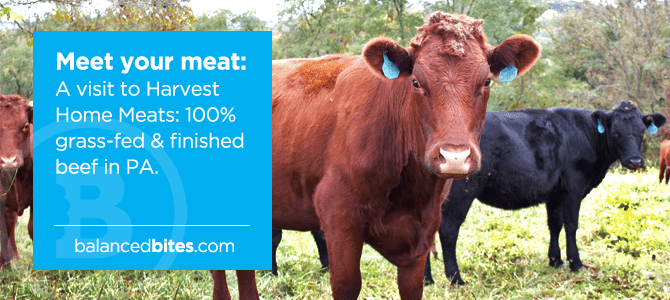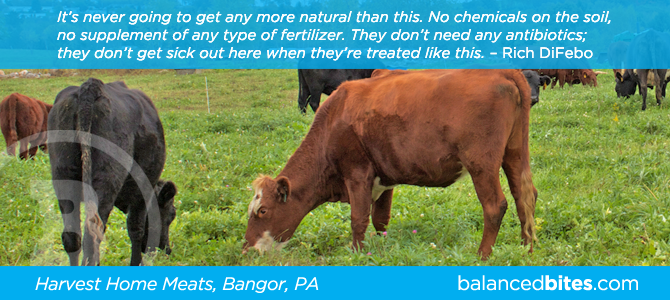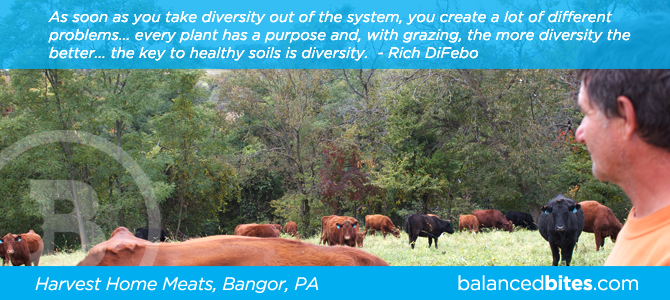As soon as you take diversity out of the system, you create a lot of different problems… every plant has a purpose and, with grazing, the more diversity the better… the key to healthy soils is diversity. – Rich DiFebo on modern-day agriculture/monoculture crops
The amount of respect that I have for those who take the time to grow and produce the highest quality meats we can eat continues to grow exponentially with each farm I visit.
After multiple visits to Clark Farm in Carlisle, MA over the past few months, I realized it was about time I meet my meat. Face to face… get right up in the faces of some cows. Moo!
A few of us at the gym have talked about getting a cow share for a few weeks now, and I decided that even before we make the purchase, I'd like to get out and actually see the farm where the cows were raised, and meet the farmer as well. I was prepared to see some cows and ask some questions. I was not prepared for how amazingly knowledgeable and eager to educate us the farmer, Rich DiFebo, would be about raising cattle.
It's never going to get any more natural than this. No chemicals on the soil. No supplement of any type of fertilizer. They don't need any antibiotics – they don't get sick out here when they're treated like this. – Rich DiFebo
About twenty years ago, Harvest Home was a dairy operation with some corn and soy growing as well. While many would rather turn the land over to mono-crops of corn and soy, DiFebo has taken great pride in raising cattle and not participating in that unsustainable system. Apparently, corn is currently going for a whopping $8/bushel, which is going to provide the dough for a shiny new tractor, as DiFebo noted, that farms down the road have, but they can't afford.
Rich DiFebo seemed like a Mayor of sorts when he started talking to us about a second, 65-acre piece of land he built into a cattle grazing farm three years ago. The additional acres are a nice, flat area where his breeding stock normally graze, but all of his cattle will move here for the winter months. Moving them around is much easier on this flat pasture than it is on his very hilly acres close to his home, so he's learned over the last several years that, while costly, this practice is much better for the cattle, since remaining on pasture year-round is what they're intended to do.
Rich told us the story of how the land was originally purchased by the local school system, that later decided not to build as-planned. Rather than allowing the previously-grown Christmas tree farm to be turned into row-crops of corn and soybeans, Rich convinced the school system to let him protect the land and turn it into pasture. The entire project was about a $40k investment, about two-thirds of which was funded by the federal government in support of a system that would offset the carbon footprint of many other crops in the area. The pasture land is now considered an environmental site for the school whose cross-country team even runs alongside the grazing areas on trails!
Almost everybody out there, we're all in the same boat. We're just trying to make a living at it – almost everybody has another job somewhere else. It's trying to be efficient. Genetics is a lot of it, but that's a slow process.Everything has to be working in your favor for this to work. – Rich DiFebo
Some of the things I learned today about grass-fed cattle:
- 100% grass-fed cattle can take up to 27-28 months to raise versus 18 months with grain-fed.
- The goal of the selection process for the heard is to grow grass efficiently, as well as to have animals who will grow quickly and yield more without the addition of any grains or feed. (Duh!)
- Some of the grasses the cattle may eat include: Orchard Grass, Perennial Ryegrass, Timothy Grass, Red Clover, and White Clover.
- Rather than raising the price of the meat, farmers need to continually become more efficient at planning their breeding and where they move the cattle.
- Too much protein in the cattle's diet (from too much Clover, for example) won't keep their gut bacteria balanced – so often hay (dried grass from another pasture where its grown solely for the purpose of feed) is added when the cattle are grazing on a mainly Clover pasture. Sound familiar?
- If you don't love the job, you can't possibly do it – you need to be passionate about it!
I am beyond excited to have the privilege of purchasing meat from this fantastic establishment. I look forward to supporting Harvest Home Meats, and Rich's family in the process of putting the best meat I can find on my plate several times a week.
If you're in the NJ/PA area, I highly recommend checking out Harvest Home Meats either directly from the farm or in the shops where it is sold locally.
For more information:
Harvest Home Meats – www.harvesthomemeats.com | Like Harvest Home Meats on Facebook!
Eat Wild – www.eatwild.com – to find a farmer near you
Local Harvest – www.localharvest.org – to find a farmers market near you (and maybe a farmer, too!)





Comments 5
Convinced me. Ordering now. Thank you.
This is great! I had planned a tour of a farm I plan to buy for, but they had to cancel their open house until later. I think everyone should do this.
This sounds great! I am fortunate to have several pasture-raised farms within a reasonable distance of me, here in the Pacific Northwest.
I’ve had the intention to visit a couple of them, and this inspires me to make that happen!
I do not know whether it’s just me or if everybody else encountering problems with your website. It appears as if some of the written text on your posts are running off the screen. Can somebody else please comment and let me know if this is happening to them too? This may be a issue with my web browser because I’ve had this happen previously.
Cheers
We all tend to be so disconnected from our food source. I think its great to have the opertunity to vist the place your food will be raised. 50 years ago organic food and pasture rasied animals were just called food. We need to return to that thought and take charge of our food and not leave it up to corporations to do it for us.